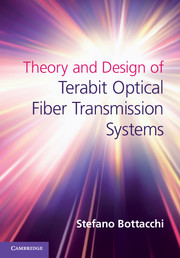Book contents
- Frontmatter
- Dedication
- Contents
- Preface
- Acknowledgments
- Part I Signals, spectra and optical modulations
- 1 Baseband signals and power spectra
- 2 Analytic signals and spectral efficiency
- 3 Optical signals, high-order modulations and spectra
- Part II Principles of light polarization and optical amplification
- Part III Interferometric optical modulators
- Part IV
- Appendix A Electromagnetic energy and power flow
- Appendix B Optical power and photon flux
- Index
- References
1 - Baseband signals and power spectra
The theorem of conjugated pulses and its application to the raised cosine autocorrelator
from Part I - Signals, spectra and optical modulations
Published online by Cambridge University Press: 05 September 2014
- Frontmatter
- Dedication
- Contents
- Preface
- Acknowledgments
- Part I Signals, spectra and optical modulations
- 1 Baseband signals and power spectra
- 2 Analytic signals and spectral efficiency
- 3 Optical signals, high-order modulations and spectra
- Part II Principles of light polarization and optical amplification
- Part III Interferometric optical modulators
- Part IV
- Appendix A Electromagnetic energy and power flow
- Appendix B Optical power and photon flux
- Index
- References
Summary
Introduction
In this chapter, we will review some relevant results of the spectral analysis of random signals, in particular the matched filter with the raised cosine output response. Owing to the characteristic property of every matched filter of generating an output pulse which is the same as the autocorrelation of the input pulse, we will present a detailed analysis of the raised cosine autocorrelator. This system represents in fact the optimum receiving filter for the given input additive white noise, providing at the same time the maximum signal-to-noise power ratio and the absence of any intersymbol interference (ISI). The raised cosine autocorrelator showing the minimum noise bandwidth is the well-known Nyquist receiver. It has a frequency response identical to the ideal frequency window of width equal to the reciprocal of the bit time. These concepts represent a valuable background well suited for the modeling and comparison of different transmission systems and photoreceiver architectures. The following sections illustrate some applications of the raised cosine autocorrelator in conjunction with specific optical modulation formats.
Section 1.2 presents the differential encoding technique, which is extensively used in the optical demodulation of differential phase shift keying (DPSK) and differential quadrature phase shift keying (DQPSK) signals. After introducing the operating principle, the section proceeds with the analysis of the encoding and decoding algorithms, showing simple circuit realizations. Section 1.3 reviews basic results concerning the autocorrelation, the power spectrum and the average power of random sequences of arbitrary pulses. Section 1.4 presents the average power theorem of conjugated pulses as a consequence of Parseval’s theorem and the symmetry property of the Fourier transform pair. The average power theorem is useful in the calculation of the average power of uncorrelated sequences of conjugated pulses, without providing the explicit solution of the integral forms. The raised cosine pulse and the ideal square pulse, in their respective conjugated domains, are illustrated as simple analytical applications of the average power theorem. The section closes with several simulations of the raised cosine pulse and of the error function pulse.
- Type
- Chapter
- Information
- Publisher: Cambridge University PressPrint publication year: 2014



